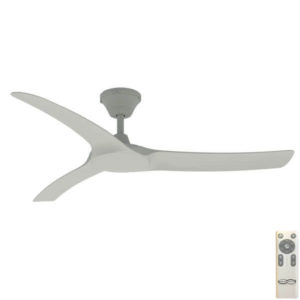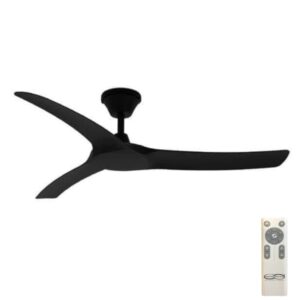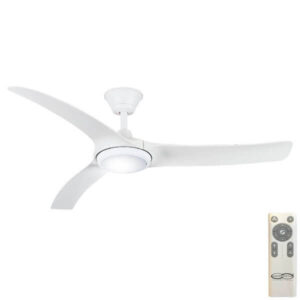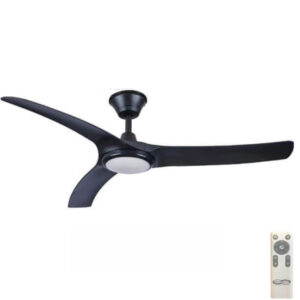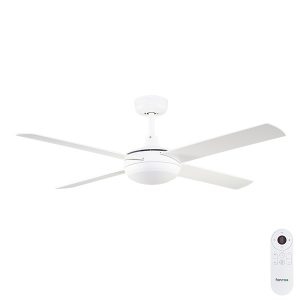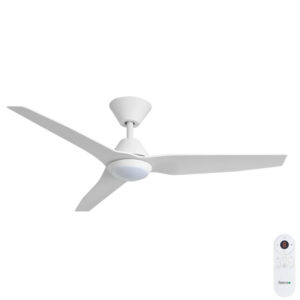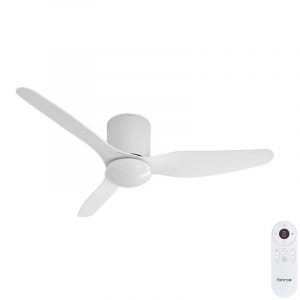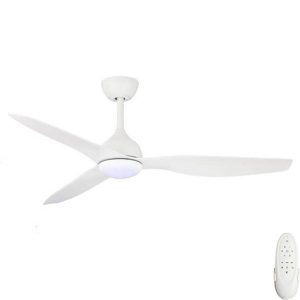Ceiling Fan Buying Guide
Ceiling Fan Buying Guide.
Welcome to the Fansonline Ultimate Ceiling Fan Buying guide. We have called upon our 15 years of experience to answer some of the most common questions relating to Ceiling Fans. Our guide has been updated for 2023 to include information relevant to the latest updates in technology and trends. Jump in to a specific topic below.
The vast majority of people find that they can install a ceiling fan in their homes.
If your ceilings are 2.4m or higher then you can usually install a fan that fits within the Australian standards. Most states require a fan to have its blades no lower than 2.1m from the floor. Please check the ceiling fan drop to measure in order to ensure that you are complying with these standards. Generally speaking you may require an extension rod if your ceiling is 2.7m or higher.
It is a mandatory requirement that your Ceiling Fan is installed by a qualified electrician. At Fansonline we have teamed up with a third party trade booking service, meaning you can now book installation post purchase. Have a read of our ceiling fan installation page to find out more.
Low profile fans have a hugger style and are great for lower ceilings. Because hugger-style fans are designed to sit flush with or “hug” the ceiling, there are no extension rods made for them. This means that if you want to install the fan on a ceiling that’s standard height or above, you won’t have the option of lowering it.
What if I live in apartment?
Apartments often have less space to access the ceiling cavity, so it might be difficult for your electrician to run wiring to power your fan. Don’t despair! If you’re living in an apartment, it may still be possible to put up a ceiling fan, but you will need to do a bit more research. It’s always a good idea to speak to an electrician to find out what you can achieve in your home.
The common workaround is to replace an existing light fixture with a remote-controlled ceiling fan. If you choose this option, the electrician will use the wiring from the old light to power the fan. Because the fan is operated by remote, it also saves running wiring to the wall control. But your installation solution will depend on your apartment, so talk to your electrician before choosing a fan.
How to Choose the size of your fan
Firstly, all fan sizes are given as the diameter (blade span) of the fan. For example, a 52″ fan will measure 52″ from the tip of one blade to the tip of the opposite blade. The greater the diameter of the fan, the more area it will cover. For lounges and living areas, 52″ and 56″ fans are generally a good place to start. In bedrooms 48″ and 52″ fans are usually popular sizes unless the room is very small or unusually large.
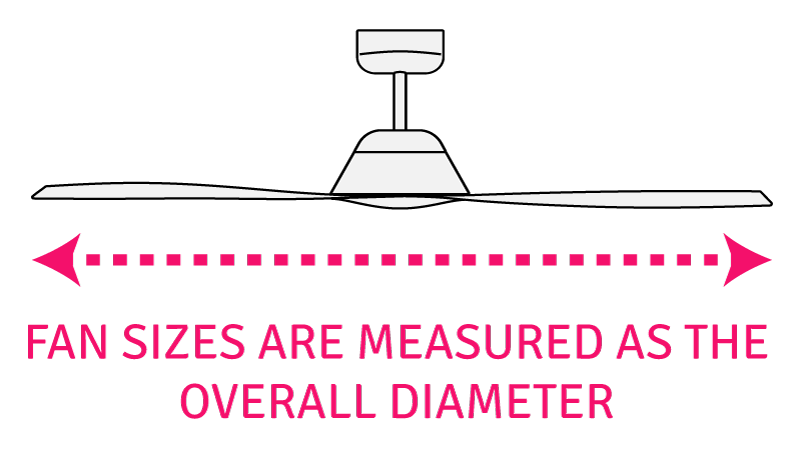
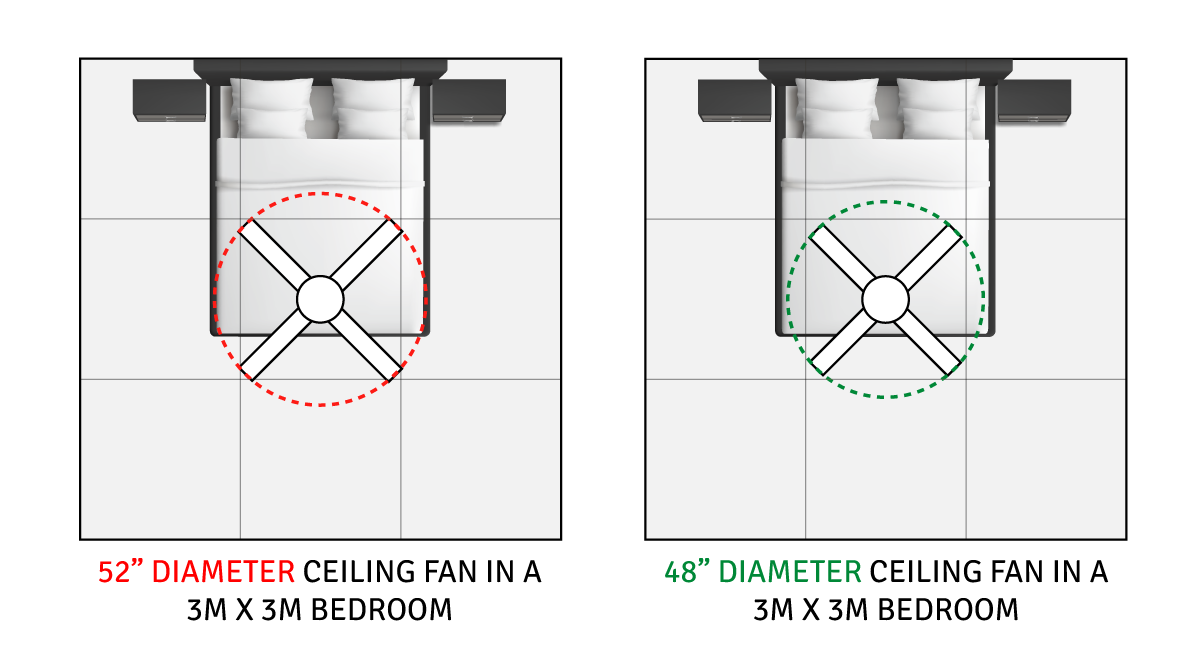
If your room is uncommonly small, we do have a Small Ceiling fan range which are 44” and below. On the other hand, if your space is quite large we have a Large Ceiling fan category with fans measuring from 54” to 95”, depending on the amount of space which needs to be covered.
Useful Tip: Most Ceiling Fans can be reversed for use in winter. This means instead of pushing air down, they will draw the air upwards. To learn more about how this feature works have a read of our using your fan in winter guide.
As Ceiling Fans are designed to provide a cooling effect by generating air movement, positioning of your fan is important. Therefore to maximise the cooling effect it is necessary to think carefully about positioning. For example a fan in a living room would be within close proximity to your sofa/chairs. A ceiling fan works by generating a breeze, moving air over your skin. For this reason there cannot be a one size fits all formula based on x room size = y size fan. The below diagram shows a 56″ diameter ceiling fan in a 6m x 6m room with the approximate air coverage illustrated in blue. For very large areas it may be necessary to install multiple fans.

Visual impact is also an important consideration. Aesthetically you may not want to have the fan stand out, therefore a moderately sized white fan may be the way to go. On the flip side you may wish to purchase a fan that becomes a statement piece. Therefore something larger may be better suited.
Useful Tip: Why not try our fans by style category? Here we present fans based on style including Scandinavian, Tropical & Industrial.
Outdoor & Coastal Locations
Australians love the outdoors, with many of us embracing outdoor living areas. The cooling breeze of a ceiling fan can help contribute to a calm and relaxing atmosphere.
If you’re looking to install a fan outdoors, then be sure to select a fan that is suitable for your intended use as environmental conditions can impact both the longevity and performance of the fan. The majority of outdoor fans will still require the area to be fully enclosed, which means completely shielded from wind and rain. When you think about it a ceiling fan is rather delicate, more often than not they come factory balanced so high winds could interfere with this. We would also recommend that an outdoor fan is installed at least 1.5m from the edge of your eave or roof.
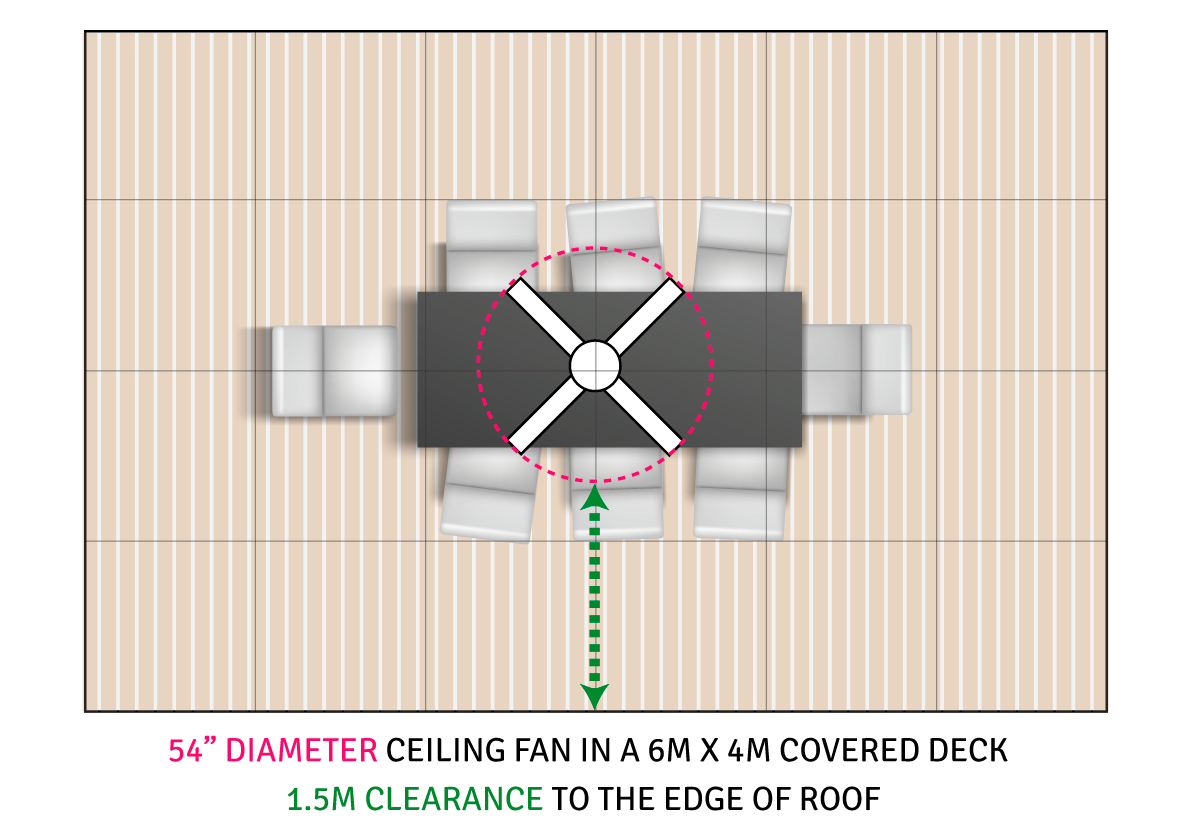
It is possible to purchase a wet rated fan. This would be a fan with more robust, sealed construction meaning it is able to withstand the elements. To find wet rated fans simply visit our outdoor ceiling fans category and use the filters on the site to select ‘outdoor- wet location’ from the installation location option. You can also look for IP ratings, which tell you how well the fan is protected against solids (eg. tools, hands, dust) and liquids.

I live near the Coast, which fan is best for me?
A coastal fan will need to withstand the demands of a coastal environment, which means the majority are ABS plastic or stainless steel construction. Purchasing an unsuitable fan may result in coastal corrosion, rust or ‘tea staining’. This can happen to a fan that is installed indoors or outdoors if you are very close to the sea.
Tip: Despite a fan being coastal rated, it is still necessary for you to regularly clean the fan in order to maintain its appearance and finish. We recommend regularly wiping the blades and motor with a damp cloth.
The below fan is an example of a class leading outdoor ceiling fan, it comes with an IP66 rating which means that it can be cleaned with a hose if required!
AC or DC motor and other considerations
DC fans first started entering the market about 8-9 years ago. At the time of writing this article we offer just over 450 AC fans in our range and over 550 DC. This goes to show how manufacturers have embraced this new technology.
Below we have put together an at a glance summary of AC & DC motors:
| AC (Alternating Current) | DC (Direct Current) |
|---|---|
| More options available at a lower price point (Lots of good quality models sub $200) | Generally more expensive, although in recent years they have become more affordable (more options in the $250 – $350 price bracket than ever before) |
| Use less electricity than most household appliances, especially air conditioners. Standard models will use no more than 90w on the highest speed. Majority of models use less | The ultimate energy efficient option – most models will consume approx. 30w on the highest speed and can be as little as 2-3w on the lowest speed! |
| Most AC fans come with a wall control but almost all are remote adaptable | Most DC fans come with remote as standard – however there are now options that include wall control. Click here to view them! |
| Typically reversible via switch on motor | Typically reversible via supplied remote |
| Typically offer 3 selectable speeds | Typically offer 5-6 selectable speeds |
Regardless of the fan motor selected, be assured that you will be purchasing a quality, energy efficient fan.
For more information visit our page on DC Ceiling Fans.
How much airflow will I need?
Airflow is the measurement of air movement generated by the fan, all published figures are based on the highest speed.
Whilst it would seem necessary to pick a fan with high airflow, realistically how important is this? From our experience this can be based on your application. For example with a bedroom ceiling fan, more often than not you will want to achieve a gentle breeze. Because of this bedroom ceiling fans are usually set to the lowest speeds, so they don’t need to be high airflow fans.
If the fan is going in a larger space, or if the fan is going to be installed a little higher than usual then you may wish to opt for a high airflow model. Generally we consider a fan with an output of 10,000 m3/hr as one that offers a high airflow output.
Blade design can also contribute to airflow direction. Some blades are designed to create a powerful downdraft, whereas others have more of a flared design and will result it the fan pushing air down and outwards.
Which blade material is best?
Some common questions we regularly receive are things like; which blade material is better? are timber blades quieter than metal blades?
To begin with there are three materials you will often be able to choose from: Plastic (ABS), Timber or Metal.
Plastic blades are becoming more and more common. They are durable, easy to clean and can be shaped into a range of unique and interesting styles. This has lead to an increase in the number of fans with curvaceous blades and lots of interesting new designs.
Timber blades are most commonly found on fans designed for indoor use. They are also lightweight and can make for an attractive complimenting feature to timber flooring. Depending on the type of timber they may not be suitable for outdoor use, for example a laminated plywood blade may end up pealing in an excessively humid environment.
Finally Metal Blades were for many years the most common blade material. You will notice that lots of older fans had metal blades. Metal can include aluminium and stainless steel, the latter makes for a robust outdoor ceiling fan construction material. Recently we have noticed that a lot of manufacturers are moving to ABS plastic blades rather than metal. Having said this there are still lots of options with metal blades available.
In our experience we have found that not one blade material is superior to another in terms of airflow. In terms of noise, a fan with metal blades may result in more of an audible ‘cutting through the air’ noise on higher speeds, but this is minimal.
How many blades should my fan have?
Technically, the number of blades on a fan can impact its performance, but so do other factors. Because fans differ in so many ways, you can’t tell how effective they are by counting their blades. Some high airflow fans have three blades, some have two, and some have five.
Of course, you should also consider your preferred fan’s performance, but make sure that you look at all of its specifications before you buy. Consider the size, the airflow, design and motor wattage to decide which fan is best for you. And if you need to choose between a three-blade fan and a four-blade fan with similar specs, let your eyes be the judge. If the other specifications are comparable, the number of blades is a design choice.
Extension Rods
Extension rods help lower your ceiling fan to an optimal height if you have a higher than standard ceiling.
Extension rods are not necessarily required when installing your ceiling fan. Whether or not you wish to use an extension rod will depend on a few factors. This will include: your ceiling height first and foremost, how low you would prefer your fan to hang granted it meets the Australian measurement requirement and how powerful the fan is. In the below example we show a standard 2.4m ceiling which does not require an additional rod. We also show a ceiling 3.5m high both with and without a rod. As you can see without an extension rod the fan sits too high, the cooling effect will not be as intended. a 90cm extension rod in this example drops the fan to a more suitable height.

If the ceiling height is more than 3m then you might benefit from using an extension rod. These usually come in a 90cm length size and the installer can then cut it to size if need be. You will generally need a 90cm rod for ceilings up to 3.7m high depending on the drop of the fan selected and how high you intend to have the fan sit. The lower you have the fan the more you will be able to feel the airflow and therefore if preferred you may wish to have it sit at 2.1m from the floor to the blades which is the minimum based on Australian regulations. Some fans come with the additional option of purchasing a 1.8m rod for those ceiling heights that exceed the 3.7m mark.
Extension Rod Guide – Based on Floor to Blade Measurement of 2.5m
Measurements below are based on a standard fan drop of 30cm and a floor to blade measurement of 2.5m. If the drop is above or below 30cm, or you intend to have the fan sit higher or lower the measurements for the extension rod will have to be adjusted accordingly.
Please contact us if you would like to discuss the options for your location and preferred height.
| Your Ceiling Height | Fan Drop | Additional Length Required | Total Length Required |
|---|---|---|---|
| 2.4m | Flush/Low profile Fan – (up to 30cm drop) | No extension rod required | No extension required |
| 2.7m | Fan Drop: 30cm or more | No extension rod required | No extension required |
| 3m | Fan Drop: 30cm or more | 20cm or less | 50cm or less (90cm rod – Cut to size) |
| 3.3m | Fan Drop: 30cm or more | 50cm or less | 80cm or less (90cm rod – Cut to size) |
| 3.6m | Fan Drop: 30cm or more | 80cm or less | 110cm or less (180cm rod – Cut to size) |
| 4m | Fan Drop: 30cm or more | 120cm or less | 150cm or less (180cm rod – Cut to size) |
| 4.3m | Fan Drop: 30cm or more | 150cm or less | 180cm or less (180cm rod – Cut to size) |
| 4.6m | Fan Drop: 30cm or more | 180cm or less | 180cm or longer rod if available cut to size |
Note that compatible extension rods are listed in the accessories section of each fan listing.
Ceiling Fans for Angled Ceilings
It is important to know the exact degree of your raked ceiling in order to determine which fans can be installed in your location. Our range varies quite a bit. Some fans are only suitable for flat ceilings, whereas others are compatible with ceilings angle up to 30+ degrees. Be sure that the ceiling fan you’ve chosen will be compatible with the degree of your vaulted ceiling. Some fans may require an additional ceiling rake kit in order to be suitable.
If you love a fan that is not suitable for your ceiling angle, one option is to fabricate a timber mounting bracket. This would be a visible bracket that reduces or completely eliminates the angle as pictured below:
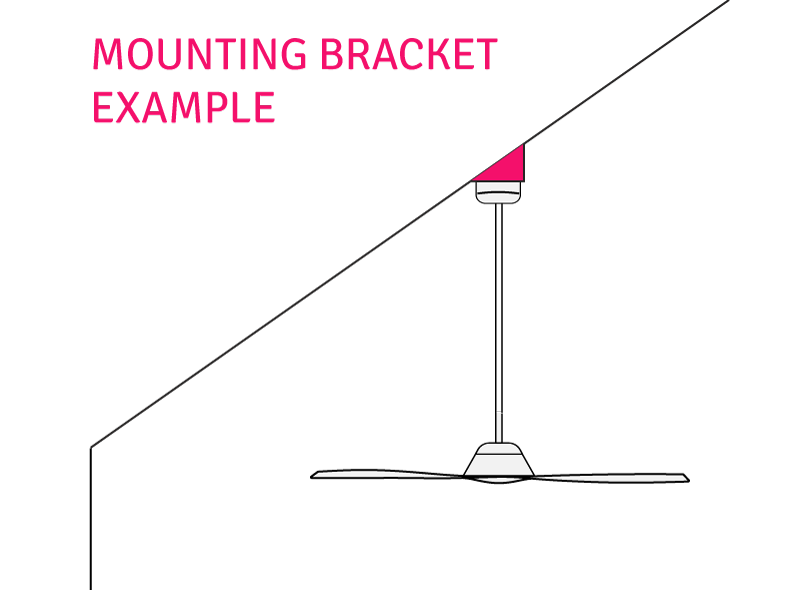
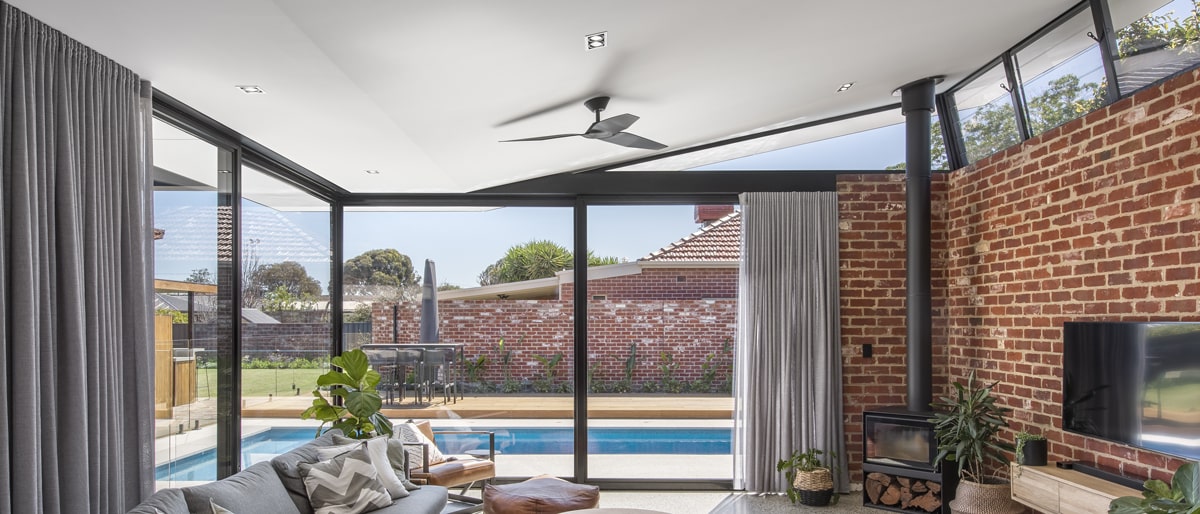
What makes a ceiling fan suitable for an angled ceiling?
Ceiling fans come equipped with a ball joint canopy. This canopy will ensure that the fan sits correctly regardless of the fact that the canopy is installed on an angle. It is very important to understand that each fan will vary in the degree of angle that it will be compatible with. For example, a ceiling fan with remote control (this includes a lot of DC fans) may require the remote receiver to be installed inside the canopy. This results in a lack of space in the canopy to allow for a steep angle. For highly angled ceilings you may also need to purchase an extension rod, to allow for an increased clearance so that the blade is not too close to the ceiling (illustrated below).
If you require any assistance regarding ceiling angles and suitable fans please contact us.

Ceiling Fan Control Options

Remote Control
Most remote controls operate using radio frequency technology. This means that the remote handpiece is set to the same frequency as the receiver which is wired to the fan. Radio frequency technology means that you do not have to point the remote at the ceiling fan for it to work. You just need to be within the required range. Traditionally, using a remote control would mean that a wall control could not be used – however new technology means that we do now have options that include the ability to operate remote and wall control in tandem.
The vast majority of DC fans will come with a remote control as standard without the option of a wall control. However, AC fans which generally come with a wall control will almost always have a remote control available as an accessory. All fans with remote control should also be wired to an isolation switch. This switch is designed to turn power supply on/off to the fan. If installing multiple DC fans in one house this will be necessary. As most DC fan remote controls have automatic pairing to the receiver you will need to ensure power is off to surrounding fans before the pairing process. It is also an important safety feature, to be able to turn off power supply to the fan.
Another thing to consider if you’re choosing a remote is that the receiver may beep when you use the handset. This indicates that the handset has successfully transmitted the command to the receiver, and is very useful for troubleshooting. The receiver may also beep when the isolation switch is turned on. This indicates that the receiver has power. However, not all remotes do this and some models even have the option of switching the beep off. If you’re looking for a remote with this option, please get in touch with us. Our staff will be happy to explore the options available to you.
Wall Control
A wall control is probably the most common style of control. Once wired by an electrician a wall control provides reliability of a fixed location control. Initially a fan with a wall control may be more expensive to have installed, as wiring will be required to the controller. Once installed there is no danger of misplacing a wall control and unlike a remote you will never need to replace batteries. With a wall control it is also very easy to determine the current speed of the fan.
Smart Control
Smart Ceiling Fan controllers take advantage of the latest technology and will allow control of your fan using a downloadable app via your smartphone. There are also options that are compatible with home automation systems such as Amazon Alexa or Google Home. A smart control will typically also come with a remote handpiece that can also be used.
Pull Cord
Pull Cords are often found on traditional style fans and just like a wall control will provide you with a fixed location means of control. Typically the pull cord is pulled to cycle through the available speeds and to turn the fan off. A pull cord may not be suitable for very high ceilings, or on the flip side may hang too low in a room with a lower ceiling. They can also be a little bit tricky to determine which speed the fan is on.
What benefits do SMART fans offer?
SMART technology allows you to do much more than operate your fan from your phone. It connects your ceiling fan to the internet and the wealth of information available online. Some of this information is particularly relevant to the way you use your ceiling fan. Depending on the app you’re using to access SMART features, you can set your fan to respond to weather changes or schedule them to switch on and off. If you have a fan with a light, you can schedule the light to turn on at sunset.
Some people with disabilities may also find SMART technology easier than a wall control or remote control to use.
Light Options
If you intend to have your ceiling fan operate as your main light source, then you’ll be looking to purchase a ceiling fan with light kit.
About LED Lights
Ceiling fans with LED Lights are considered to be more energy efficient and come in different colour temperatures. Most LED lights will consume between 18-30 watts, by contrast an E27 globe may be more like 60 watts. Considering most LED lights will provide the same level of brightness as a couple of globes, if used regularly this will equate to tangible energy savings.
A fan with an integrated LED light will typically consist of many small diodes, so not only is an LED light more energy efficient, it also provides a more even distribution of light with less ‘shadowing’ compared to a light fixture with globes.
Whilst most LED lights are designed to last a long, long time one consideration is how to replace the light in the event of failure. Firstly most will be covered by a manufacturers warranty. Beyond the warranty period most manufacturers are able to supply replacement parts. However some will require an electrician to install a replacement. Please contact us for some options of fans that have replacement panels readily available.
Light Temperature
The temperature of a the light (measured in Kelvins) determines the colour of the light.
3000k (Warm White) – This is the most common and has a yellow tinge which is considered calming and relaxing.
4200k (Neutral White) – This LED light temperature is quite natural, also referred to as natural white as it is the most similar to sunlight.
5000k (Cool White) – This temperature gives a clean, modern look. It looks brighter to the eye as it contains more blue light.
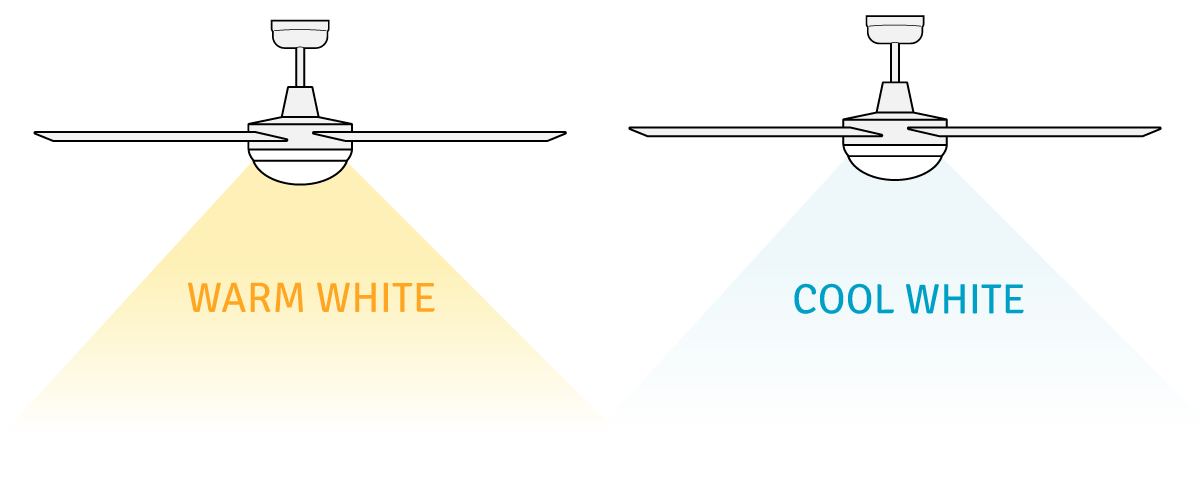
Not sure which temperature is best? Then go for a CCT Light…
CCT stands for ‘colour changing technology’. A fan with CCT technology will provide you with the ability to choose the light temperature. How to change the light temperature can differ from model to model. Sometimes this can be in the form of a small switch accessed by removing the light diffuser, on other models it may be a setting available on the remote control. This is a great feature as you will have the flexibility to adjust the temperature based on your preference.
Looking for a Bright Light? Look for High Lumens…
Lumens (Lm) refer to the amount of visible light to the human eye. The higher the lumens the brighter the light will appear. Before LED technology wattage would often correlate with lumens, so higher wattage would equal more brightness. This is not the case with LED lighting, therefore it is important to know the Lumens of the light fixture.
What if you are worried about the brightness?
Of course it is possible for a light to be ‘too bright’. If you have any concerns about brightness we would recommend looking for a ceiling fan with a dimmable light. There are now many options available, most of which will offer the ability to dim the light from the remote control.
What are the other options besides LED?
Whilst advances in LED technology have lead to this becoming the most common style of light, there are also many models that will take a standard globe. Whilst we have already spoken about the advantages of dedicated LED lights, globes also have their place. For starters replacing a globe is a very simple and relatively inexpensive process. Secondly you are able to pick your favourite type of globe (in terms of temperature), you may even wish to use a smart globe. As long as the globe does not exceed the manufacturers recommended max wattage and is the correct type (eg B22, E27) you will be fine.
What are Watts?
The wattage of a light gives an indication of the amount of energy the bulb will consume and is not indicative of the amount of light it will generate. Therefore, just because the wattage is higher on one bulb does not mean it will be brighter than one with a lower wattage. If you intend to identify how bright a light actually is check the listing for the Lumen data figure.
Each light fixture will take a specific wattage, so before purchasing a globe make sure it will be compatible with your fan. Using a higher wattage bulb than the limit specified will produce excess heat. This may become a safety hazard and could potentially damage the fans light fixture.
CLASS LEADING MODELS WITH DIMMABLE CCT LED LIGHTS & USER REPLACABLE LED PANELS
-

Fanco Eco Silent Deluxe DC SMART Ceiling Fan with CCT LED Light & Remote – White 52″
4.80 – 5 reviews$399.00 -

Fanco Infinity-iD DC Ceiling Fan SMART/Remote with Dimmable CCT LED Light – White 48″
4.74 – 19 reviews$399.00 -

Fanco Studio SMART DC Low Profile Ceiling Fan with Dimmable CCT LED & Remote – White 48″
4.80 – 5 reviews$389.00 -
Ceiling Fans without Light & Downlights
If you prefer the look of a ceiling fan without a light in conjunction with an alternative lighting source (such as downlights) it is important to consider positioning of lights in order to avoid a ‘strobing’ effect. This can happen if the ceiling fan is too close to one of your downlights.
Do you have any other questions? Drop us an email and we will be more than happy to help!
The information is general in nature and does not constitute specific advice to any client. Fansonline does not take responsibility for a client’s choice of fan or accessories. If you’d like more specialised help and to discuss the options for your space, our friendly sales team will be more than happy to assist.

